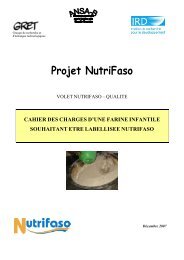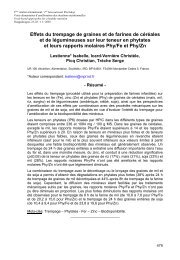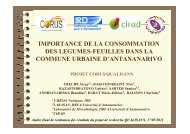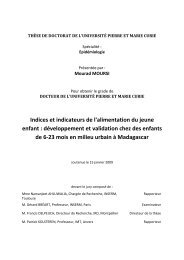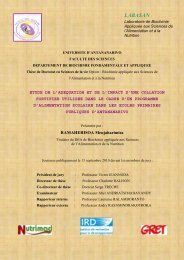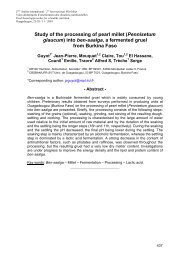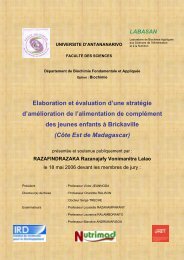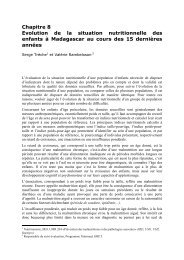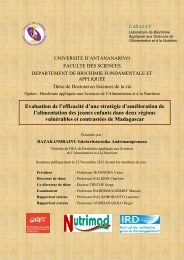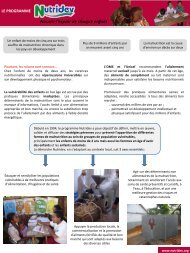THESE UNIQUE El Hassane Kéhien-Piho TOU - Nutridev
THESE UNIQUE El Hassane Kéhien-Piho TOU - Nutridev
THESE UNIQUE El Hassane Kéhien-Piho TOU - Nutridev
Create successful ePaper yourself
Turn your PDF publications into a flip-book with our unique Google optimized e-Paper software.
ARTICLE IN PRESS<br />
LWT 40 (2007) 1561–1569<br />
www.elsevier.com/locate/lwt<br />
Improving the nutritional quality of ben-saalga, a traditional fermented<br />
millet-based gruel, by co-fermenting millet with groundnut and<br />
modifying the processing method<br />
E.H. Tou a,b , C. Mouquet-Rivier a,b, , C. Picq c , A.S. Traore`<br />
a , S. Tre` che c , J.P. Guyot c<br />
a UR106 (Nutrition, Alimentation, Sociétés), Institut de Recherche pour le Développement (IRD), 01 BP 182, Ouagadougou, Burkina Faso, France<br />
b Université de Ouagadougou /UFR-SVT/ CRSBAN, Burkina Faso, France<br />
c UR106 (Nutrition, Alimentation, Sociétés), Institut de Recherche pour le Développement, BP 64501, F-34394 Montpellier cedex 5, France<br />
Received 11 July 2006; received in revised form 2 November 2006; accepted 6 December 2006<br />
Abstract<br />
To improve the nutritional value of ben-saalga, a traditional gruel from Burkina Faso, co-fermentation of millet and groundnut (MG)<br />
was monitored using either the traditional processing method (MG-T) or a modified processing method including precooking, addition<br />
of malt and inoculation by backslopping (MG-CMI). Fermentation kinetics and microbial composition in the two processing methods<br />
were characterized and compared to that of ben-saalga process used as control. The fermented pastes from control, MG-T and MG-CMI<br />
experiments had a low pH of around 3.9. Their microbiota were dominated by lactic acid bacteria (LAB) with amylolytic LAB:LAB<br />
ratios of respectively 12%, 4% and 15%. In MG-T paste, glucose and fructose were the main substrates for lactic acid fermentation and<br />
their concentration decreased during settling, whereas in MG-CMI paste, the main substrate was maltose and its concentration increased<br />
transiently. At a suitable consistency, the dry matter content of MG-CMI gruel was almost twice as high as that of ben-saalga. During the<br />
three processing methods, phytate content decreased of about 75%, 50% and 66%, respectively. Thanks to the incorporation of<br />
groundnut, the macronutrient balance of MG-T and MG-CMI met the requirements for complementary foods but only the MG-CMI<br />
gruel had sufficient energy density.<br />
r 2007 Published by <strong>El</strong>sevier Ltd. on behalf of Swiss Society of Food Science and Technology.<br />
Keywords: Pearl millet; Groundnut; Complementary food; Nutritional quality; Lactic acid fermentation<br />
1. Introduction<br />
Malnutrition is a public health concern in most<br />
developing countries. In Burkina Faso, according to the<br />
last demographic and health survey conducted in 2003, the<br />
prevalence of stunting, underweight and wasting reached<br />
39%, 38% and 19%, respectively (INSD & Macro<br />
International, 2004). Examination of the causes of malnutrition<br />
(ACC/SCN, 2000) revealed that the nutrition<br />
status of young children depends on multiple factors<br />
among which the quality of complementary feeding is<br />
Corresponding author. UR106 (Nutrition, Alimentation, Sociétés),<br />
Institut de Recherche pour le Développement, BP 64501, F-34394<br />
Montpellier cedex 5, France.Tel.: +3 3467416295.<br />
E-mail address: claire.mouquet@ird.bf (C. Mouquet-Rivier).<br />
essential. This includes child-care practices and the nutritional<br />
value of complementary foods.<br />
In West Africa, the most widely-consumed complementary<br />
foods are local cereal-based gruels prepared in small<br />
production units or in households (Cornu, Tre` che,<br />
Massamba, & Delpeuch, 1993). The preparation of several<br />
of these foods includes a lactic acid fermentation step<br />
(Tomkins, Alnwick, & Haggerty, 1988; Blandino, Al-<br />
Aseeri, Pandiella, Cantero, & Webb, 2003). Although<br />
fermentation has some nutritionally positive effects such as<br />
a reduction in phytate content, or an increase in the<br />
contents of certain vitamins, the nutritional value of these<br />
gruels is very low (Westby & Gallat, 1991; Lorri &<br />
Svanberg, 1994; Tou et al., 2006). Protein, lipid and energy<br />
contents are generally well below the values recommended<br />
for complementary foods by Dewey and Brown (2003). In<br />
0023-6438/$30.00 r 2007 Published by <strong>El</strong>sevier Ltd. on behalf of Swiss Society of Food Science and Technology.<br />
doi:10.1016/j.lwt.2006.12.001



